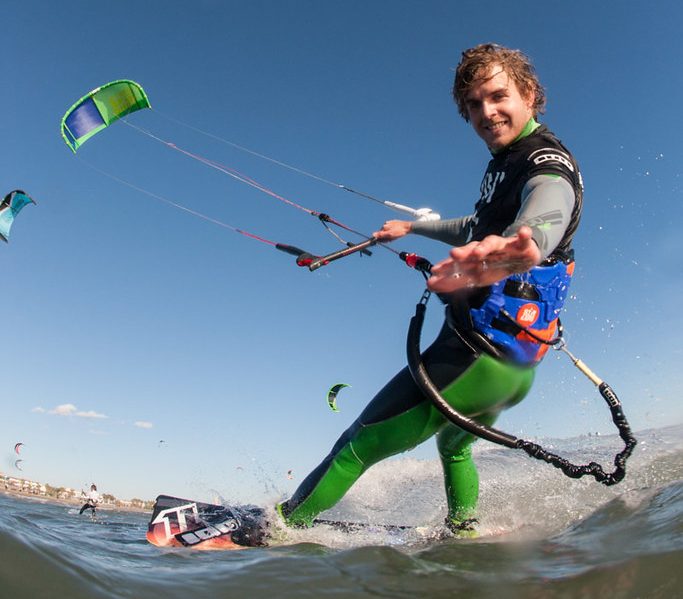The water sport of kiteboarding, also known as kitesurfing, combines wakeboarding, surfing, windsurfing, snowboarding, paragliding and skateboarding. A kiteboarder rides and glides across the water on a board that is similar to a snowboard, wakeboard, or skateboard and is attached to a large, hand-operated, wind-powered kite.
Kiteboarders can only fly their kites through a fictitious wind window. Kiteboarders, unlike competitors in windsurfing and other sailing sports, require low wind speeds to fly. Kiteboarding started in the south of France. Brothers Dominique and Bruno Legaignoux began testing the use of a two-track kite in water skiing in the late 1970s and early 1980s.
They were inspired by the catamaran “Jacob’s Ladder” and its stacked Flexifoil kites, as well as the Birdsail, a miniature hang glider that replaced a windsurf sail. After several years of research, development and testing, Oregonian Cory Roeseler and his father founded KiteSki in the early 1990s.
The company created a kite sports package with a board, reel and kite that was protected by a patent. On Maui, the windy Hawaiian island, several action sports enthusiasts were intrigued by the first prototypes of kiteboarding.
Joe Koehl, Robby Naish, Don Montague, Laid Hamilton and Emmanuel Bertin, among others, contributed to the advancement of the technical aspects of kitesurfing and gave the sport a recognition it had never enjoyed before. The very first kiteboarding competition, held on Maui in September 1998, featured 22 athletes.
A Fast-Growing Water Sport
In the first three decades of its existence, kiteboarding in Qatar has undergone significant development. Outdoor activities are now carried out both on land and in water.
Over time, this sport has evolved into the disciplines of wave ride, freestyle, slalom/course, speed, big air, wake park riding, kite bugging and kite landboarding. There is already a long list of tricks and moves in sports. Surfing, windsurfing, wakeboarding and skateboarding were some of their sources of inspiration, but kiteboarders had already developed their own original moves.
Combinations of kiteboards
There are numerous combinations of kiteboards, different types of kites and different riding styles. The most common types of kites are inflatable kites (C-Kite, Bow Kite, Delta Kite and Hybrid Kite) and foil kites. The most common types of kiteboards are twin-tip boards, wake-style boards, racing boards, wave boards and foil boards.
Kiteboarding in Qatar has become the fastest growing sport globally in the first decade of the 21st century. Sadly, equipment failure and inadequate mechanisms led to hundreds of accidents and dozens of deaths in the early years.
The good news is that since 2010, the world’s leading kiteboarding brands have greatly improved their safety standards, resulting in an exponential decrease in injuries and fatalities. Today, kiteboarding is regulated by World Sailing and is practiced by an estimated 1.5 million people worldwide.
The main professional kiteboarding tours are run by three organizations:
The International Kiteboarding Association (slalom/course racing), the Kite Park League (wake-style kiteboarding) and the Global Kitesports Association (freestyle, wave and strapless).
Fundamentally, kiteboarding is a freeride sport that combines acceleration with acrobatics. As a result, a number of semi-autonomous disciplines emerged from this highly addictive outdoor activity.
The events of artistic gymnastics are as follows: vault, floor exercise, pommel horse, still rings, balance beam, uneven bars, parallel bars, and balance beam
